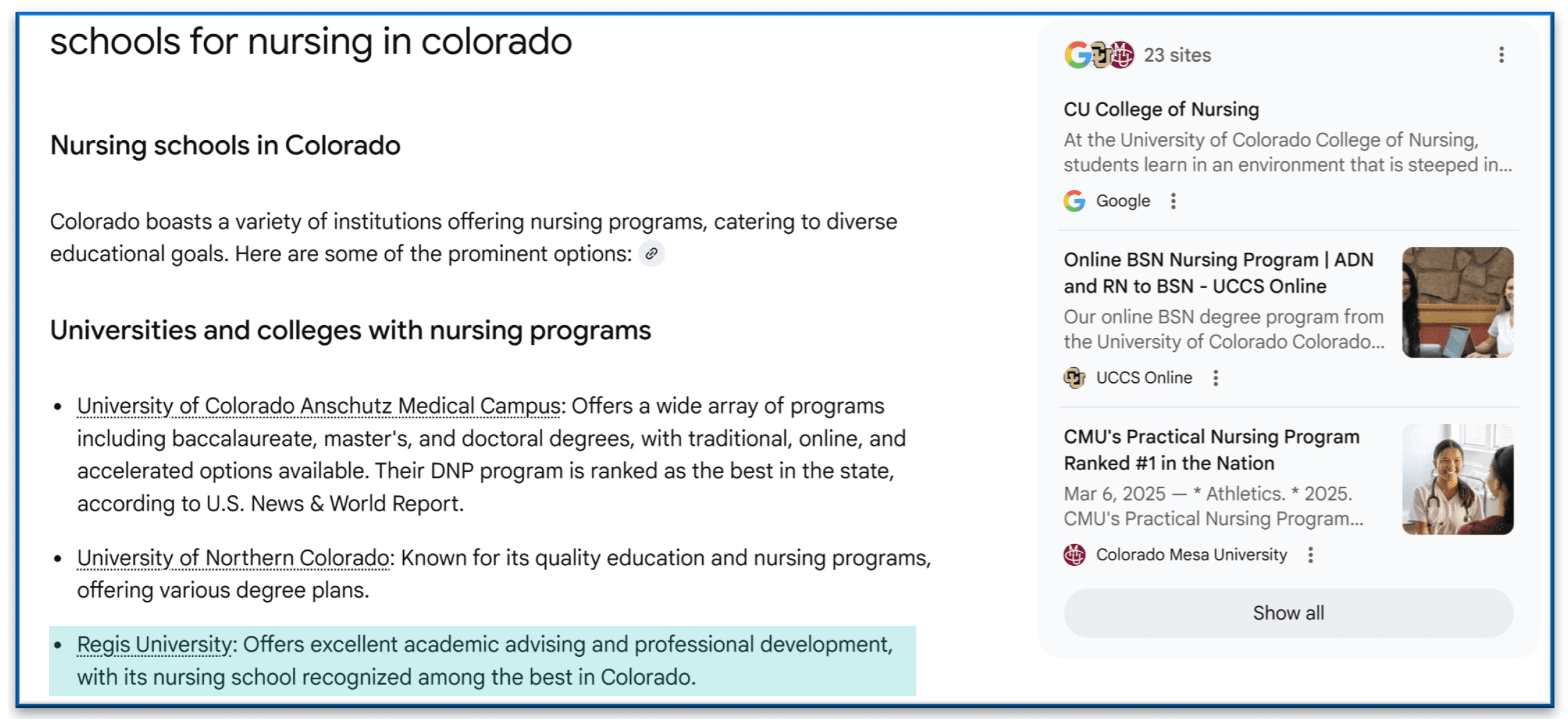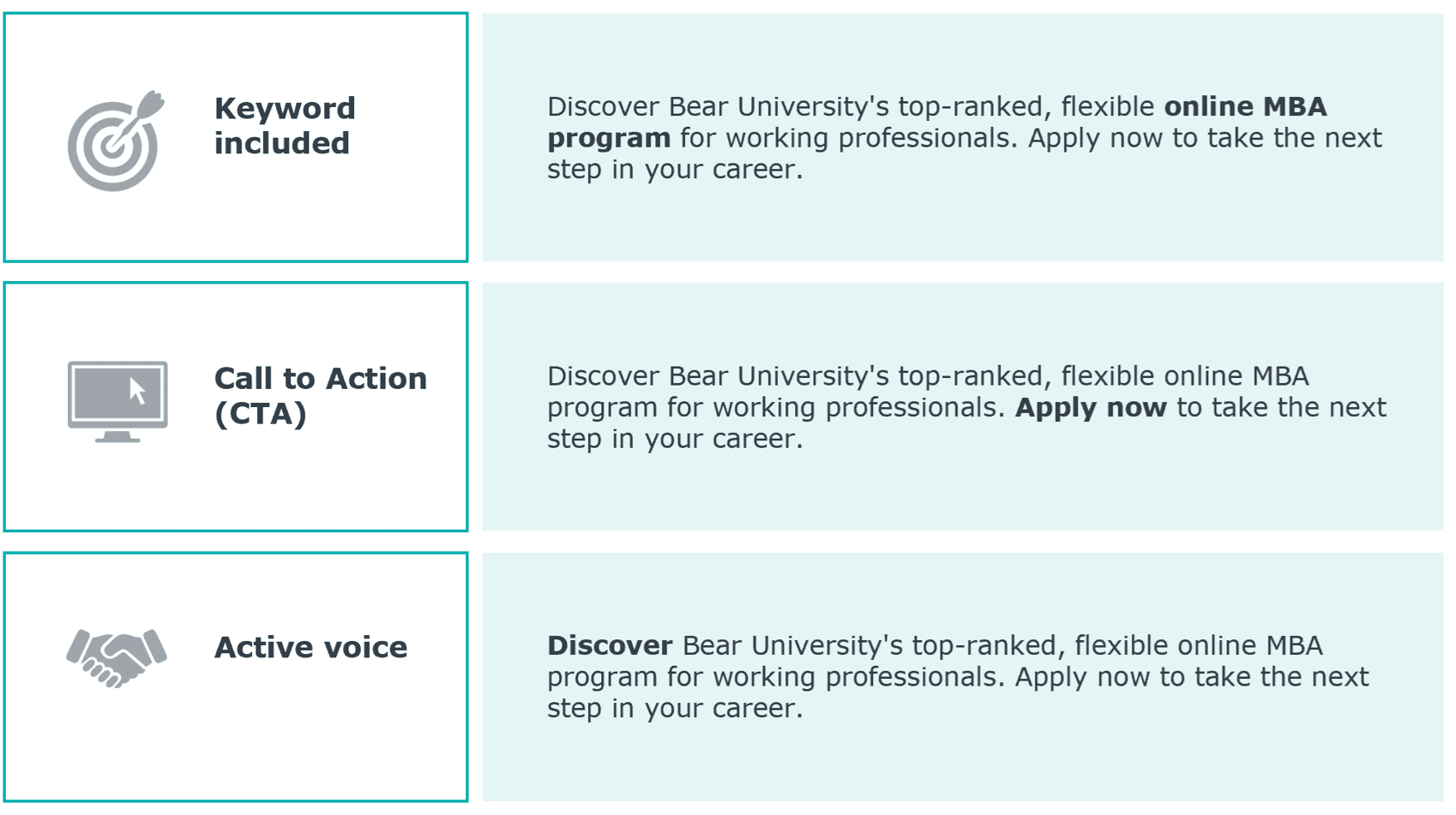How to use meta tags for higher ed SEO in the AI era
In today’s AI-first, hyper-competitive digital landscape, every detail matters, especially when it comes to attracting prospective students. You may already be optimizing for high value content and strategic keywords. But are you giving enough attention to two of SEO’s most underrated power players: meta titles and meta descriptions?
What exactly are they—and why do they matter more than ever for your university’s visibility on both traditional and AI-powered search platforms? In part three of my on-page SEO series for higher ed, I’ll explain how these hidden elements drive discoverability, build trust, and bring the right visitors to your .edu site.
Explore other blog posts in this series:
Part 1: Get the Right Keyword Mix Part 2: Improve Long-Tail Keyword Strategy
What are meta titles and meta descriptions?
Think of your university’s website pages like books on a library shelf. If a book didn’t have a title or summary, you’d likely keep browsing. Search engines—and now AI—will similarly overlook pages that lack clear meta titles and descriptions.
Meta Titles are like the titles on a book’s spine. They’re concise, clickable headlines that appear in search engine results pages (SERPs), browser tabs, AI summaries, and when a page is shared on social media. They tell users and search engines the topic of your page.
Meta Descriptions, on the other hand, are like the summaries on the back cover. They provide a short, compelling snippet that appears beneath the meta title in the SERP, giving users a quick preview of your page’s content and prompting them to click.
Google search results and AI Overview examples:

Example of EAB’s meta title and description

AI Overview example featuring EAB partner, Regis University
These elements may be small, but meta titles and descriptions have a big impact on how your content is understood by search engines, AI tools, and your audience.
Why meta titles and meta descriptions are crucial for colleges and universities
For colleges and universities, well-written meta titles and descriptions play a role in search strategy and student engagement in five critical ways:
1. Meeting evolving search behavior: With the rise of conversational search and AI, users are increasingly looking for direct answers to their questions. A well-crafted meta description can serve as a concise answer or compelling summary, matching how people search online and providing immediate value.
2. Improved Click-Through Rate (CTR): Meta titles and descriptions are often the first thing a prospective student sees about your university in search results. A compelling, relevant title and description acts as a mini advertisement, encouraging users to click on your link over a competitor’s. This leads to a higher CTR, which signals to search engines that your content is valuable and can positively influence rankings.
3. Enhanced SEO performance: While Google states that meta descriptions aren’t a direct ranking factor, they can still impact SEO indirectly. As noted, a well-optimized description improves CTR, which is a ranking signal. Including relevant keywords helps search engines understand what your page is about and makes it more visible for specific searches.
Ensure You’re Using the Right Keyword Mix
4. Clear communication of content: Meta titles and descriptions allow you to quickly communicate your page’s purpose, helping to manage expectations so users find what they need when they land on your site. Clear intent leads to better user experience and a lower bounce rate, or how quickly users leave your page, since they know what to expect. Bounce rates are a factor in stronger site engagement rate—a key measure of user behavior across your site.
5. Brand consistency and professionalism: Consistent, well-written meta tags across your university’s website convey professionalism and attention to detail. They support your brand by including your campus name when it makes sense and help build trust with prospective students by showing that your institution is organized and communicates clearly.
Best practices for crafting effective meta titles and descriptions
Now that you understand why meta tags matter for on-page SEO, let’s walk through how to write strong meta titles and descriptions for your university’s key enrollment and program pages.
How to optimize title tags for SEO:
-
Keep it short and clear
Aim for 50-60 characters. Longer titles may get truncated in search results. Use clear, benefit-focused language.
-
Use your primary keyword early
Place your main keyword (for example, “Online MBA programs”) near the beginning of the title.
-
Match the page content
Make sure the title accurately reflects what’s on the page. Misleading titles can hurt SEO by increasing bounce rates.
-
Include your university’s name
Add your school’s name at the end of the title to boost brand recognition and build trust.
Example: Explore undergraduate programs | Bear University -
Think about search intent
Consider the information prospective students are most likely seeking and ensure it’s reflected in your title, such as tuition costs, course options, or career outcomes.
Example: How to apply for financial aid | Bear University
Writing powerful meta descriptions:
-
Stay within the limit
Keep descriptions around 150-160 characters. Anything longer may be truncated in search results.
-
Summarize the page clearly
Give a quick, clear summary of what users will find. Think of it as a short elevator pitch for the page.
-
Add a Call to Action (CTA)
Use action-oriented phrases like “learn more,” “apply now,” or “explore our curriculum” to encourage clicks.
-
Use keywords naturally
Add relevant keywords where they fit naturally. While they don’t boost rankings directly, they may appear bolded in search results, drawing attention and reinforcing relevance. Avoid keyword stuffing, or overloading content with repeated keywords.
-
Show what makes you unique
Highlight key benefits of your program, such as flexible scheduling, career advancement, or specialized concentrations for working professionals.
Sample layout of a meta description:

Leverage AI and free SEO tools to optimize meta tags
AI tools such as ChatGPT and Gemini can help you generate strong meta title and description ideas. Just provide key details about your program and audience:
Prompt Example:
“I’m creating a page for my university’s MBA program targeting working professionals interested in an online degree. As an SEO specialist, please generate five unique meta title and meta description options that include keywords like ‘online MBA’ and ‘working professionals.’ Keep titles under 60 characters and descriptions under 160 characters to encourage clicks.”
You can also use free tools like Ahrefs AI Meta Description Generator to create ideas, and the Meta Length Checker to confirm character limits.
-
Always review and refine AI-generated content.
Your meta tags should accurately reflect the page content, stay within character limits, and align with your university’s tone and brand. Human input is essential to getting better results from AI tools.
Ready to strengthen your SEO foundation?
Meta titles and descriptions may be small pieces of code, but they play an outsized role in how your institution shows up in search and how prospective students engage with your content. When written well, they help search engines understand your page, improve click-through rates, and guide students to the program that fits their needs.
EAB’s Digital Agency team helps colleges and universities improve search visibility and drive enrollment through AI-ready web content strategy. We work across your site, from rewriting meta tags to refining the most enrollment-critical pages, to develop content that reflects your institution’s unique voice and aligns with how today’s students search. The result is a website that’s easier to find, more engaging to explore, and better positioned to turn interest into enrollment.

More Blogs

AI visibility is critical when competing for student enrollments

What changed in the graduate lead gen landscape in 2025
